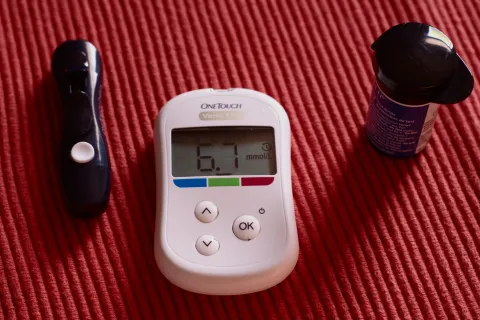Parent of Teen with Autism Seeks Help with Narrowing Food Choices
“My daughter is 16 and at age 2 was diagnosed with PDD-NOS [pervasive developmental disorder not otherwise specified – a former category of autism spectrum disorder]. She was eating well at that point. But since then, her food choices have narrowed to chips and breadsticks. She has such an intense gag reflex that even looking at or smelling other foods makes her gag and vomit. We need help.”
Editor’s note: The following information is not meant to diagnose or treat and should not take the place of personal consultation, as appropriate, with a qualified healthcare professional and/or behavioral therapist.
Today’s “Food for Thought” answer is by registered dietician Hope Wills, of the Autism Speaks Autism Treatment Network site at Children's Hospital Los Angeles.
Many children, teens and adults with autism are challenged by change – not only in their diets but also in other aspects of daily life.
Related to this issue, we’ve noticed that many children with autism prefer processed foods over home-cooked dishes. This may be because home-cooked foods tend to taste a little different each time you make it. By contrast, a particular brand of chips or other packaged food is likely to taste the same every time you open the box or bag.
Because of this sensitivity to “sameness,” we recommend against trying to trick such a person into trying something new by disguising it as something familiar. Sometimes, such well-meaning strategies can backfire and lead to a distrust of food. We’ve seen cases where children will stop eating or, as with your daughter, trust only a few simple foods.
Getting expert guidance
If possible, I recommend that you find consult with feeding specialist experienced in helping individuals who have autism. At ATN centers such as ours, we work with many children with a wide range of food and eating challenges.
Perhaps your daughter is already seeing a behavioral, occupational or speech therapist. He or she may be able to help your daughter with her eating issues, as well.
Whether you work with a feeding specialist or behavioral therapist, you can help by providing detailed descriptions of what types of foods present a challenge for your daughter. I also suggest that you jot down some notes about how she responds to foods she likes as well as foods that upset her.
These insights into her personal challenges will help the feeding specialist work with you and your daughter to expand her acceptance of new foods.
Meanwhile, here are a few strategies that you can try at home:
Offer food at room temperature. Heated foods can produce strong aromas that can feel overwhelming to a person with food aversions. Offering food at room temperature can reduce or avoid this problem.
Don’t sneak. As I mentioned, whenever you offer new or previously rejected food, do so openly. Many of our parents complain that their child insists on smelling foods before eating. I help them understand that their children are using their senses to determine whether the food is familiar and “safe.”
Start in your child’s comfort zone. You mention that your daughter likes chips and breadsticks. Great. Try offering some spreads and dips to go with them. Yogurt and hummus, for example, can add protein to her diet. You may also want to consider foods with a shape or “crunch” similar to those of her favorite chips and breadsticks. Examples might include toast cut into narrow sticks. Crunchy, freeze-dried fruits may provide some new tastes with a familiar texture.
Take small steps. Start by exposing your daughter to a new food with no expectations that she will have to eat it. It sounds like your daughter – like many individuals with strong food sensitivities – has a strong negative reaction to even looking at a new food. So try the following small steps.
1. Place a new food in a sealed sandwich bag on the meal table where your daughter can see it. Give her a timer. (Egg timers with bells are usually great.) Explain that you’ll leave the sealed food on the table for a set amount of time, which she will gradually increase. Then let her decide how long to set the timer. Even one minute is okay. Over a few days, allow her to work up to, say, five minutes.
Remember, change is hard. I encourage parents to find enjoyable shared activities and offer them as a reward for achieving a goal. However, I strongly recommend against taking away activities or toys if your child fails to achieve a goal. In other words, stick to positive rewards – something in addition to your usual activities.
2. In the next phase of this exposure, place the food in an open cup in the same spot on the table. Again, have your daughter use the timer to increase how long it will remain there. Be patient.
3. Next step: Place the open cup of food on her plate, with no expectation that she eat it.
4. Once she can tolerate the food on her plate, the two of you can discuss the next steps toward taking a taste. For instance, she might touch the food and/or smell it.
Provide a complete multivitamin-mineral supplement. It’s understandable to worry about whether a narrow eater is getting adequate nutrition. A complete vitamin-mineral supplement can reduce your stress. It may even encourage her to eat, as a low intake of certain nutrients like zinc can decrease appetite.
Of course, some children won’t swallow a tablet or eat a chewable supplement. Many of the parents we see at our ATN site report success when they crush a chewable supplement into applesauce or flavored gelatin. I don’t recommend “gummy vitamins” because they don’t provide all the key nutrients. Plus, they’re too easy to mistake for candy and, so, present an overdose danger.
Since your daughter is a teenager, another appropriate choice would be an adult liquid vitamin such as Centrum Liquid.
Become a food egalitarian. As parents, we can focus too much on getting our children to eat what we consider “good” foods. When we tell our children that they need to eat their vegetables before their dessert, we’re conveying the message that one type of food has more value then another. In the case of a selective eater, I think it’s important to loosen up a little. I encourage parents to see the value in their child simply trying a different food. So if your daughter is willing to try a crunchy cookie before she tries a bite of chicken, that’s okay. The goal is for her to try both. The order doesn’t matter.
Remember to ask for help. I’ll wrap up my advice where I began: I strongly recommend working with a care team that includes a feeding therapist (typically an occupational therapist or speech pathologist), a dietitian and a mental health clinician.
A feeding therapist can assess your child for sensory issues related to taste and texture.
The mental health clinician can help you create a structure for introducing new flavors and textures in ways that reduce the stress on you and your daughter.
The dietitian can provide guidance on the types of foods that will improve the quality your daughter’s nutrition, as well as advise you on methods to prepare foods in a manner that is acceptable to your daughter.
A good place to look for such a team is at an autism clinic such as those in the Autism Speaks ATN. (See the links below to find the site nearest you.)
You and your daughter deserve help and support as you move forward. In addition to the assistance of professionals, I hope you will engage key caregivers, including teachers, in the process. In this way, your daughter can receive consistent support and expectations.
I wish you all the best. Please let us know how you’re doing in the comment section below or by emailing us again at gotquestions@autismspeaks.org.
For more helpful tips, also see the Autism Speaks ATN/AIR-P Guide to Exploring Feeding Behavior in Autism. This tool kit provides guidance from a broad range of experts in the Autism Speaks Autism Treatment Network
Editor’s note: The above information is not meant to diagnose or treat and should not take the place of personal consultation, as appropriate, with a qualified healthcare professional and/or behavioral therapist.








